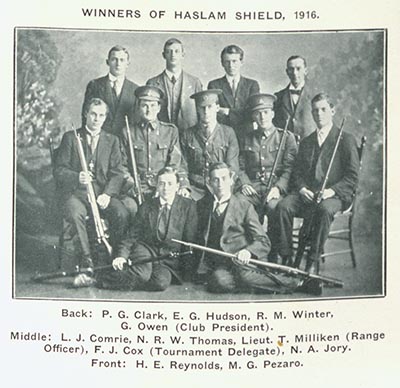
Leslie Comrie in later life.© Godfrey Argent Studio
'The task of writing about these our heroes is one which stirs many conflicting emotions. I confess it - and that without shame - that oftimes as I have sat writing of someone with whom perhaps I may have sat at school or college, a vision of the body which was will float before my eyes, and I stop to brush away tears'.
From Leslie Comrie's introduction to the published Roll in the 1916 issue of The Kiwi magazine.The Kiwi: Official Organ of the Auckland University College. NZGC 378.95 K62, Special Collections, University of Auckland Libraries and Learning Services.

Leslie Comrie, middle row, left. The entire 1916 Haslam Shield winning Rifle Club team served in the War. Evan Gibb Hudson and Paul Graham Clark were both killed in action in 1918.The Kiwi: Official Organ of the Auckland University College. NZGC 378.95 K62, Special Collections, University of Auckland Libraries and Learning Services.
Leslie Comrie
For the first four years, much of the hard work compiling the Auckland University College Roll of Honour was undertaken by science student Leslie Comrie.
Comrie’s name appears repeatedly in the Auckland University College Students’ Association (AUCSA) and Auckland University College (AUC) records relating to the Roll and he was responsible for this detailed introduction to the Roll in the 1916 The Kiwi magazine. Even after Comrie enlisted in early 1917 and left for training camp, he continued to help out with the Roll. The introduction to the Roll in the 1917 Kiwi noted 'Corporal Comrie, who is now on Head Quarter’s staff at Tauherenikau, has rendered valuable assistance by supplying us with information concerning addresses and promotions of men in camp'.1
Leslie Comrie was born at Pukekohe in 1893, and was educated at Pukekohe High School and Auckland Grammar School. He attended AUC from 1912 to 1916, graduating with a Bachelor of Arts in 1915 and a Master of Arts in Chemistry in 1916.2 Comrie was a keen student and enthusiastic participant in many aspects of College life. As well as his involvement with the AUCSA and associated Roll of Honour work, Comrie was a founding member of the College Rifle Club3 and was part of the club’s Haslam Shield-winning team in 1915 and 1916.4 In 1915, Comrie was also Secretary of the Tennis Club, the AUC Scientific Society and a member of the Executive Committee for the Men’s Common Room.5 It was also at AUC that Comrie developed an interest in astronomy, gazing at the heavens through a six-inch telescope which was mounted on top of the Old Parliament Buildings, which then served as the College’s home.
Wartime
Comrie had been partly deaf since childhood and, in an interview with the New Zealand Listener in 1948, he explained how he had tried to join the military again and again until he finally 'got in by a mixture of good luck and guile'.6 During military training at Trentham, his deafness was discovered when an instructor, Captain Cheator, gave Comrie an order in his bad ear. As a result, Comrie was given an office job, but, as with most aspects of his life, he persisted and in April 1918 he finally embarked for the Front. In September 1918, just days after joining the 1st Battalion of the 3rd New Zealand (Rifle) Brigade in France, Comrie was severely wounded by a shell, “a British one at that”, and he lost his left leg.7
Post-war
While recovering in England, Comrie was offered the opportunity to continue his university studies and he spent eight months at University College, London. There, Comrie’s interest turned from chemistry to mathematics and in particular the use of calculating machines. In 1919, he was awarded a New Zealand Expeditionary Force Scholarship to study at St John’s College, Cambridge. He was awarded Cambridge’s Isaac Newton Scholarship in 1920 and a Ph.D. in 1923 for his work on occultations of stars by planets.8
After graduating, Comrie spent three years in the United States teaching astronomy and computational science at Swarthmore College and North Western University, Evanston, Illinois. In 1925, he returned to England to take up an appointment at His Majesty’s Nautical Almanac Office, Greenwich, where he was Superintendent from 1930 to 1936. In 1937, Comrie founded one of the world’s first private scientific computing companies, Scientific Computing Service Ltd, which during the Second World War produced ballistic, bombing and geodetic tables for the Allies.9
Comrie was a world leader in many aspects of computing, including the use of punched card equipment for scientific calculations. In December 2000, in recognition of his achievements, the main mathematics and statistics computer laboratory at the University of Auckland was named in his honour.10 Comrie was a fellow of the Royal Astronomical Society and the Royal Society. He was married twice, first in 1920 to Noeline Dagger, with whom he had one son, and then in 1933 to Phyllis Kitto, with whom he had another son.11 Comrie died in London in December 1950, aged 57.12
Katherine Pawley, Special Collections
- The Kiwi: Official Organ of the Auckland University College, 12, 1917, p.5.
- ‘Comrie, Leslie John, F.R.S.’, in A.H. McLintock, ed., An Encyclopaedia of New Zealand, Wellington, vol.1, 1966, available online at Te Ara - The Encyclopedia of New Zealand, updated 23 April 2009, accessed 2 July 2014.
- The Kiwi, 9, 1, 1914, p.24.
- The Kiwi, 11, 1916, p.66.
- The Kiwi, 10, 1, 1915, pp.28–29, 33, 34.
- ‘From Pukekohe to the Nautical Almanac’, New Zealand Listener, 18, 447, 1948, pp.24–25.
- ibid., p.24.
- ‘Comrie, Leslie John, F.R.S.’
- ibid.
- Newsletter of the New Zealand Mathematical Society (Inc.), 81, 2001, accessed 2 July 2014.
- Mary Croarken, ‘Comrie, Leslie John’, in T. Hockey, ed., Biographical Encyclopedia of Astronomers, Berlin and Heidelberg, 2007, accessed 10 June 2014.
- ibid.


